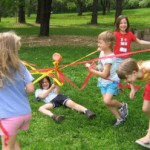 The wisdom of crowds has obviously had a huge range of applications over the past few years, but one of the more interesting has been in the field of environmentalism. A number of these have already been covered on the blog, such as the Natural Capital Project, which is using Flickr photos to understand tourism trends in national parks. Or you have the REDD+ project that is looking to crowdsource understanding of how much co2 is trapped in our forest areas. Gamification has even been applied via the Bioscore project that aims to improve biodiversity decision making.
The wisdom of crowds has obviously had a huge range of applications over the past few years, but one of the more interesting has been in the field of environmentalism. A number of these have already been covered on the blog, such as the Natural Capital Project, which is using Flickr photos to understand tourism trends in national parks. Or you have the REDD+ project that is looking to crowdsource understanding of how much co2 is trapped in our forest areas. Gamification has even been applied via the Bioscore project that aims to improve biodiversity decision making.
Fascinating stuff. The latest project of this nature to cross my bows is NatureNet, which is a citizen science system designed to collect and capture biodiversity data within national parks. Visitors to various parks are encouraged both to collect biodiversity data, but also to have a say in how management systems should be designed. The aim is very much to create a crowd of people with a serious stake in the success of each park who will work well together to ensure its continued success.
The system works across both mobile and desktop devices. Park users can monitor and record data using a mobile app, including photos, video, sounds, observations, and locations. This data is then transferred to the server device when they are back at the entrance to the park.
A paper looking at the most effective design of such a system has recently been produced in conjunction with the 17th ACM conference on Computer supported cooperative work & social computing. The paper describes the original four ‘modes’ of the application:
- Maps, Views, & Data: an interactive view of the nature park with scatterviews that show categories of photos, bio-diversity data associated with photos, design ideas, and people.
- People & Groups: information about individuals that have contributed, including their bio-diversity observations and design ideas.
- Be a Scientist: bio-diversity data contributions; access to conversations about biodiversity data.
- Be a Designer: contribution and discussion of design ideas.
Most of the input into better systems design comes via ideation in six main areas:
- Ideas submission and management:This is a basic feedback exercise, allowing people to suggest new features they would like to see.
- Ideas comments/votes: These ideas are then commented and voted upon by other members of the community.
- Idea selection: The best ideas are then selected by the design team based upon the above.
- Idea implementation: This is an interesting stage, as those with programming skills can modify and upgrade the open source software.
- Idea integration: These upgrades are then integrated into the core app by the design team.
- System modification: Tabletop and mobile apps are installed as a version in the park by the design team or local naturalists.
The hope is that each of these six areas for involvement will provide the crowd with enough areas of potential involvement to offer something for everyone. The paper concludes with some initial findings from the NatureNet project, revealing that despite it being early days, the project has already obtained some good engagement with park users.